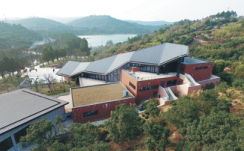PORCELAIN POWER
A rare variety of ancient celadon, whose production technique was lost more than a millennium ago, has captivated the public's imagination, Hu Yuyan and Ma Zhenhuan report in Cixi, Zhejiang province.

They were placed inside a lacquered wooden box, wrapped in silk and hidden in an underground treasure chamber that had been sealed for more than a thousand years-until an accidental discovery 33 years ago.
They were 13 pieces of the legendary mise celadon, discovered in 1987 in Famen Temple's underground palace in Baoji, Shaanxi province, when work was being done on the holy site.
The Chinese characters for "mise ware "were inscribed on a stone tablet in the palace. It listed items that Tang Dynasty (618-907) emperors had presented to Buddha.
Mise (literally, "secret-color") celadon was created using a technique lost more than a millennium ago. It was primarily produced for the imperial court.
Prior to the discovery, people could only imagine its beauty based on limited clues from ancient texts, such as a poem that compares mise celadon to "a piece of the moon dyed with spring water".
In 2016, mise celadon was unearthed at the Housi'ao kiln, part of the Yue Kiln Sites at Shanglin Lake in Cixi, Zhejiang province. Studies have shown that this was the much-admired porcelain's production site.
Mise ware represents the finest of Yue celadon, which features a grayish shade of green and tactility that make it jade-like.
"One thing that sets mise celadon apart is its crystalline texture," says Du Liuqi, a staff member at the Shanglin Lake Yue Kiln Museum in Cixi.
"A mise vessel is so smooth and translucent that it looks like there is water in it when there isn't. To ensure the quality of mise, ceramists made its sagger using the same fine materials for making the ware itself to minimize contamination during firing, as opposed to the containers made of average-quality clay for regular celadon.
"Saggers for mise ware were non-reusable because they were sealed with glaze for maximum protection and had to be broken to retrieve the finished products."
The Yue kilns at Shanglin Lake produced celadon for more than a millennium. Celadon has become part of the identity of Cixi, whose city logo features a mise vase.
To bring the ancient art closer to people, the Shanglin Lake Yue Kiln Museum offers celadon-themed workshops on weekends and public holidays.
Participants can try their hand at making and painting celadon themselves at these free events. Talks about the culture and history of celadon are also organized for students and the general public.
An archaeological park featuring the Yue Kiln Sites at Shanglin Lake opened in 2017.It offers free admission and receives an average of 340,000 visits a year, park authorities say.
"The technique for making mise celadon remains a mystery," Du says.
It continues to be one of the "best-kept secrets" of Chinese ceramics.


Today's Top News
- Xi urges villagers in Xizang to uphold ethnic solidarity
- Digital tax sparks breakdown in US-Canada trade talks
- Expert debunks Lai's 'four elements' argument for Taiwan's so-called statehood
- China opposes any tariff deal made at its expense: commerce ministry
- Nepal's hydropower a climate change solution
- UN Charter still guiding compass of humankind






























